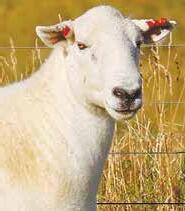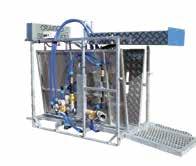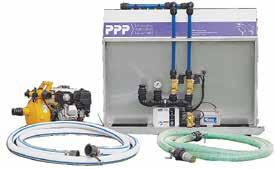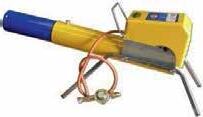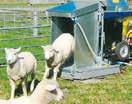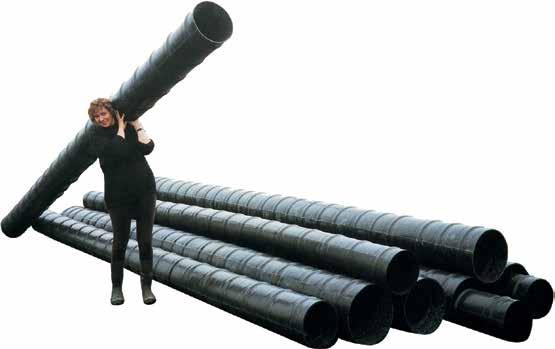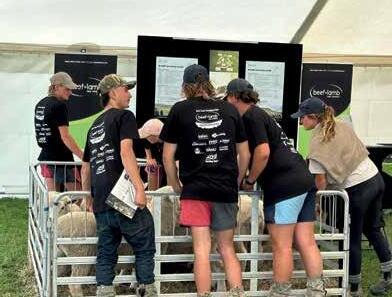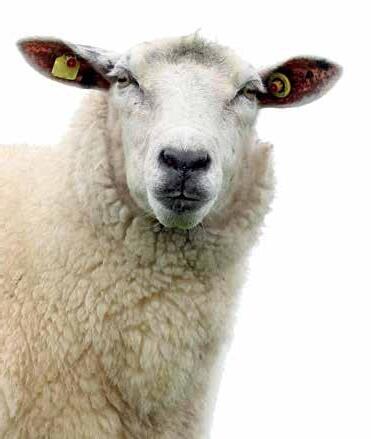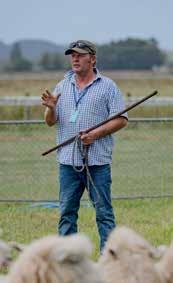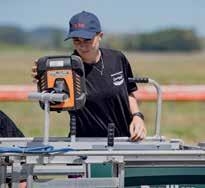






PRIME MINISTER Christopher Luxon
has rubbished a report that suggests the primary sector could take a $10 billion hit if genetically modified organisms (GMOs) are released into the environment.
He says New Zealand can both produce high quality food for a growing middle class around the world, while embracing genetic modification technology.
A report commissioned by Organics Aotearoa New Zealand (OANZ) claims that primary sector exports could reduce by $10 billion to $20b annually were GMOs to be released into the environment.
“I disagree completely,” Luxon told Rural News in Mystery Creek, Waikato where he met with around 400 farmers as part of Federated Farmers’ Restoring Farmer Confidence Tour.
“As I have said before, the Indo Pacific region is growing significantly and there’s huge demand for NZ food,” says Luxon.
“We already feed 40 million people around the world and as people move out of poverty into the middle classes, they want high quality food. That’s where we come in.”
Luxon notes that GM-related technology, such as lower-emitting ryegrasses, are available in other parts of the world but not to NZ farmers.
“We are serious about delivering our climate change goals, which we will deliver through technology and
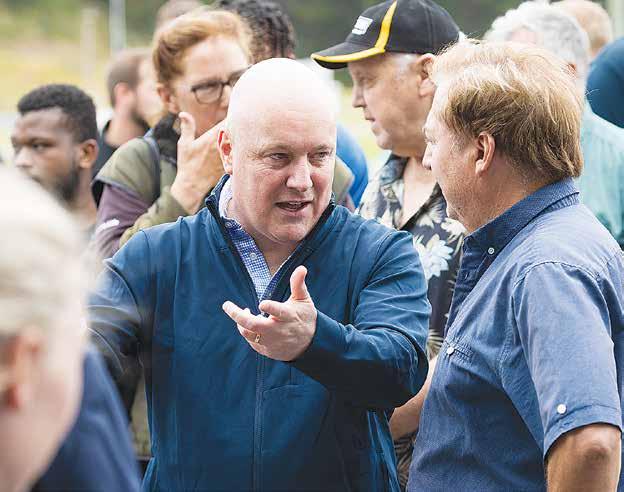
through innovation. Also, we also don’t want to be at a disadvantage to other countries that we compete with.
“We have said we will look [at it] very conservatively, that we get a great regulator, put checks and balances in place and we manage it well.”
Luxon says the GM debate has moved on from where it was 25 years ago, pointing out that chief science advisors and the last two governments
came out in support of what his government was doing.
During the meeting at Mystery Creek, Luxon was questioned about GM technology and how his government planned to handle it.
He told farmers that they were among the best in the world when it comes to producing high quality food. But he warned that the day the country stopped adopting new technology,
farmers would lose their competitive edge.
“We as government are not going to make our farmers work with one hand tied behind their backs when it comes to new technology.”
But the OANZ report, by the New Zealand Institute of Economic Research (NZIER), warns that the costs as well as potential benefits of deregulating gene technology need to
be carefully considered in considering new regulations.
NZIER study authors Dr Bill KayeBlake and Thomas Hughes note that the government’s proposed regulatory changes, as outlined by information from the Ministry of Business, Innovation & Employment (MBIE), do not include a Regulatory Impact Statement, economic assessment or cost-benefit analysis.
The coalition Government has announced the effective ban on gene editing would be scrapped by the end of next year. A bill, based on Australia’s legislation, would be introduced to relax restrictions and set up a regulator.
The NZIER report concludes that “a discussion of gene technology in New Zealand should include all the economic actors affected and quantitative analysis to understand the impacts”.
“The quantitative analysis we have been able to conduct with limited time and resources suggests that the environmental release of GMOs in New Zealand could reduce exports from the primary sector by up to $10 billion to $20 billion annually,” says the report.
“NZIER understands that gene technology has potential benefits, as outlined by MBIE (2024). As professional economists, we also understand that there is no free lunch.
“Any assessment of the potential of gene technology should also account for possible costs. We hope this provides a first step in understanding these costs.”






✔ Adjustable Minimum & Maximum on/off control
✔ Lengthen your pumps life with less on/off cycles
✔ Delivers high volumes of water (1275 lpm @ 12 bar) HIGH PERFORMANCE TANK / RESERVOIR VALVE
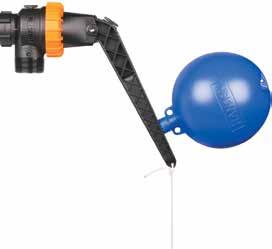
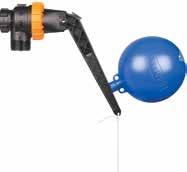







✔ See at a glance your tank water level
✔ Protect your system from water loss damage
✔ Suitable for any type or size tank
✔ 50% STRONGER - 16mm stainless steel tubes offer 50% more strength than 12mm tubes

SUDESH KISSUN sudeshk@ruralnews.co.nz
PRIME MINISTER Christopher Luxon says excessive regulation imposed by the previous government has resulted in an ‘obstruction economy’.
Speaking to about 400 farmers at Mystery Creek last week, Luxon said the country needs smart regulations but not red tape.
“Red tape has no benefit, and we need to clear that out of our system, big time,” said Luxon.
“It’s slowing our primary sector. My government has set out to liberate the sector.”
The meeting was the first of three planned as part of Federated Farmers’ Restoring Farmer Confidence Tour. A second meeting was held in Christchurch last Friday.
Luxon says farmers tell him that some of them spend 25-30% of their time doing costs and compliance administration.
“That is just sheer red tape without benefits.”
Luxon says the previous Labour government had 23 different regula-

tions put into place for the farming sector.
“That’s like 10 tennis balls being served at [once] and at the same time you don’t hit any of them,” he says.
Luxon says his government is dismantling unworkable regulations put in place by Labour. He told farmers that Wellington’s war against farmers has ended.
“We trust farmers. We ask you directly how things should work, rather than being told by our officials in Wellington. We know that change can drive certainty, but we want to give you certainty by cutting costs and red tape.”
Federated Farmers president Wayne
Langford says farmers want to know “what will bring confidence back to farming”. He says it’s been a tough year for most farmers.
“We can’t hide from the fact that a large number of sheep, dairy and beef farms have been bumping bills out month to month.”
He notes that the situation was exacerbated by the previous government putting a “fair few expectations” on farming.
“The new government has taken time to take these regulations off.”
Langford notes that farmer confidence was at an all-time low 18 months ago. He says a return of confidence would allow farmers to invest in their properties, grow their businesses and hand them over to the next generation.
He says next year is looking positive with signs of lamb prices lifting, interest rates dropping and farm input prices stabilising.
He says farmers won’t need to pay for their emissions from 2025, which was “a crazy idea anyway”.
“For the first time in a long time, farmers are being heard and being respected,” says Langford.
INTERNATIONAL TRADE expert
Stephen Jacobi says there could be “chaos” if President-elect Donald Trump sticks to his plan to slap high tariffs on goods from three key import markets.
While New Zealand isn’t in Trump’s direct line-of-fire, Jacobi believes NZ exporters to the US will be worried.
Jacobi, the executive director of NZ International Business Forum and a member of the APEC Business Advisory Council, says things remain uncertain and speculative at this stage.
“It’s hard to say at this point, but if President Trump were to do what
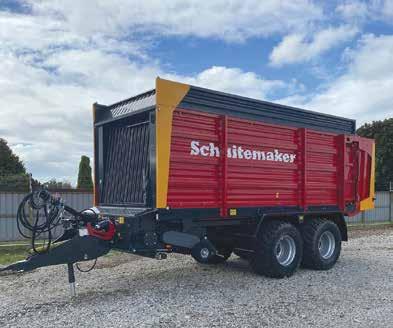
he says he intends to do – raise tariffs of 25% to Canada and Mexico, plus up to 50% for China, plus 10-20% for everyone else – we could see chaos,” he told Rural News.
“Trade disputes morphing into trade wars and considerable trade diversion as products are switched between markets.
“I know NZ exporters are concerned. They may not worry about things that are so uncertain and speculative, but there is no doubt that NZ’s exports, worth $9 billion, to the US would be impacted negatively if the tariff increases were to proceed.”
Jacobi notes that the previous
Trump administration negotiated the US, Mexico and Canada free trade deal, so any tariffs would be a surprise.
“At another level I’m not surprised because nothing this gentleman does should come as a surprise.
I would be surprised – pleasantly – if he decides not to raise tariffs.”
Jacobi expects countries hit by Trump’s tariffs to retaliate.
“I expect they will apply tariffs on US exports to their markets.
That’s what the Mexican President has already said. It’s what China did last time.
“But I imagine everyone will want to strike a ‘deal’ of some
sort. It’s also not a straightforward thing to implement tariffs in a highly integrated North American manufacturing market, where componentry may cross the border several times as part of complex supply chains.
“We can only expect China to respond as they did last time with tariffs of their own on US exports. We may see some fall-out of American products being re-routed to other markets to which we are selling.
“We saw that last time, especially in horticulture. It all depends on how any tariff increase is applied (if at all), the products it applies to and the timing.” – Sudesh Kissun

PETER BURKE
SHIPMENTS OF live animals by sea should be possible in the second half of next year, according to Associate Agriculture Minister Andrew Hoggard. He told Rural News that Cabinet has approved new regulations to be drafted and expects this to take around three months, after which the Bill will be introduced into parliament.
The Bill will then be referred to the Primary Production Select Committee before a parliament vote. With the support of three coalition partners – National, ACT and NZ First – the Bill
is expected to pass.
The coalition Government’s plan to reverse the live export ban imposed by the last Labour government has drawn opposition, including a 50,000-signature petition presented to parliament to derail the change. There has also been opposition from animal welfare groups, some veterinarians and rural professionals.
But Hoggard says the vets he’s talked to support the changes.
“For me it’s about providing options for farmers because if everyone is pushed into doing only one way that will dampen the price for everyone. I disagree with the claims that live
exports will only benefit a few people,” he says.
According to Hoggard, if some animals are allowed to be exported overseas it will lessen the number of animals on the NZ market, meaning prices will rise for all farmers. He says people should not be lured into doing things in just one way and says NZ was founded on the spirit of giving things a crack.
“I can give an assurance that the Government is committed to making sure that when the trade is reinstated, we will have the highest standards of animal welfare,” he says
While the Bill is being drafted Hog-
gard says targeted consultation with key stakeholders including animal welfare groups will take place and such feedback will help shape the legislation. He says given this, he’d be surprised if anything new came out in the select committee process, but adds that in the past this has happened.
“This is a specialised trade, so it is important that we test details with those involved in the live export by sea system. This will inform decisions on regulations and standards. The public will have an opportunity to comment on these proposals through the release of a discussion document next year,” he says.
One thing that continues to bug Hoggard is photos and images that show poor and often terrible situations for animals being sent overseas by ship. He says he would challenge the people who put up such images to state the name of the ship and when and where it left from.
“People are seeing these images think this is what we are doing in NZ and that is definitely not the case,” he says.
But Hoggard says if people have recent images from NZ about poor conditions or incidents on livestock, let him know and if it’s wrong it’ll get fixed.
and the wider sphere of other family-owned businesses.
ON THE same day that the protesters against David Seymour’s Treaty Principles Bill marched on Parliament in Wellington, on the other side of the world, UK farmers were also marching on London.
An estimated 45,000 converged on Whitehall, a short distance from Parliament and a stone’s throw from number 11 Downing Street, the home of the Chancellor of the Exchequer, who announced several measures in October’s budget that would have far-reaching implications on agriculture
The headline news was the chancellor’s decision to reduce inheritance tax reliefs from April 2026, striking a huge blow to farmers’ confidence. Currently, farmers on their death can pass down their businesses to a spouse or children without any type of taxation, by claiming 100% Agricultural Property Relief (APR) and Business Property Relief (BPR).
From April 2026, APR and BPR will be capped at £1m, with values above this only benefitting from 50% relief, effectively delivering a

20% tax on any assets over £1m to the successor, which can be paid off over 10 years.
The Treasury has
claimed around 500 farms a year will be affected, meaning 73% of farms would not have to pay the tax, based

on HMRC figures from 2021-22 which showed there were 462 inherited farms valued above £1m that year.

The Country Land and Business Association (CLA), alongside a myriad of rural advisors has said the changes could impact 70,000 UK farms over time.
This estimate is made based on land being valued at an average cost of £10,000/ acre, meaning 100 acres will hit the £1m threshold, with the value of growing crops, seeds, fertilisers and plant and machinery quickly pushing these values towards £2m.
Speakers at the protest pointed out that while farmers were asset rich, they were largely cash poor, with current average profits of
around £40,000 per year, with the likely solution of needing to sell land to meet the inheritance tax debt – a move that itself would result in a separate Capital Gains Tax.
Raising a huge round of applause, celebrity Jeremy Clarkson sent a message to government, saying, “For the sake of every farmer or landowner paralysed by a fog of despair that has been foisted on them, I beg the government to be big and accept that this measure was rushed through. It wasn’t thought out properly and is a huge mistake, so please admit this and back down.”


PETER BURKE peterb@ruralnews.co.nz
AFTER SPENDING 20
years running her own successful environmental consultancy in Central Otago, Kate Scott is ready for a new challenge.
The new chief executive of Horticulture NZ (HortNZ) told Rural News that she’s energised and keen to contribute to the broader primary sector rather than just at a regional level which is what she was doing.
“As a collaborative person I come into the role to bring people together not just horticulture but also the broader sector,” says Scott.
“The fact is that I have really diverse range of experience and knowledge - not just horticulture but also dairy, sheep and viticulture,” she says.
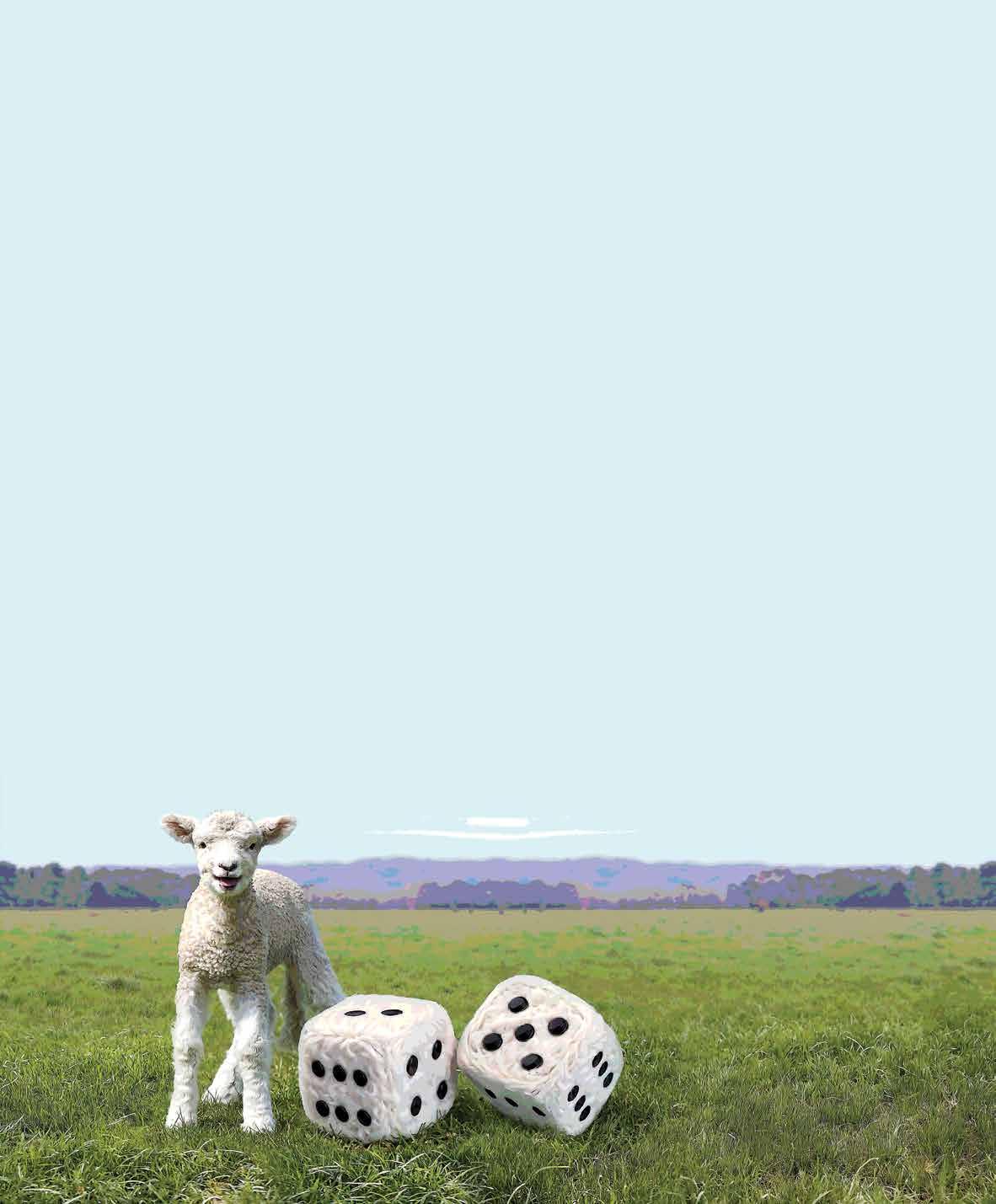
The shape of the whole primary sector is changing with a decline of smaller operators and the emergence of family corporates and larger entities. Horticulture is no different, says Scott.
“There are a number of small family businesses that have been an integral part of the sector in the last 100 years or more; we need to make sure that we support them as well as the larger entities,” she says.
Scott says the demands of the larger scale businesses are different to the small ones and the challenge for HortNZ is having the skills to navigate that spectrum. She says in her previous role she has done just that.
“At the end of the day we are there for all the growers and the challenge

is meeting their respective needs,” she says.
The debate around land use has been going
on for many years. The horticulture sector has been fighting an ongoing battle with local author-
ities to preserve highly productive land being lost forever to urban sprawl.
Scott says this is one of
the biggest issues that she’s had to deal with over the past 20-plus years.
She says it’s a case of finding a balance of what is good for the environment and good for the people and says that taking a binary of view of right or wrong is not always the best.
“I would like to say that horticulture is part of the solution to land use change and diversification.
“Like any land use we have to question where and how we do things and in order for us to flourish we need to actually take a holistic approach, because of the interconnected nature of all these challenges,” she says.
Scott notes that there are very positive things happening in the sector.
This includes it being a record year for kiwifruit, and cherries down south looking good provided the rain holds off. But she warns that vegetable growers are facing challenges around being able to grow in a way that they aren’t tripped up by regulation.
“I think that is a particular [issue] for vegetable growers about how they balance the needs of our community around accessing fresh vegetables but in a way that enables them to do that well,” she says.
In recent months some large commercial growers say the way the regulations are being implemented will likely force them out of business and Kate Scott says there needs to be a ‘common sense’ approach to regulations.

RURAL WOMEN New Zealand’s (RWNZ) new president, Sandra Matthews, says the cancellation of rural school bus services could have devastating consequences.
This year, the Ministry of Education has reviewed 290 of its 1,990 school bus routes. Of those, 38 have been or will be cancelled.
Matthews says these decisions are proving to have widespread consequences for rural families and communities.
“We are aware of families that will now have to
drive more than an hour each way to take their tamariki [children] to school, which is unsustainable for working parents and their employers alike,” Matthews told Rural News.
She says this is leading some families to contemplate moving away from rural areas altogether to ensure their children can access education.
“This threatens the very viability of our rural communities,” Matthews says.
Matthews says the issue is the Ministry of Education’s guidelines for rural school bus services, which she labels as “out-
dated”.
Currently, there are three criteria for a student to be applicable for transport assistance from the Ministry of Education:
The student must enrol at the nearest state or state-integrated school they can enrol at.
The student must live more than 3.2km (Years 1-8) or 4.8km (Years 9-13) from the school.
The student cannot have access to public transport.
Additionally, a minimum of eight children must catch the bus on the route for it to continue running.

Matthews says this number needs to be lowered to account for the realities of smaller, modern rural communities which have fewer people but “are no less important than larger communities”.
She says RWNZ has requested a meeting with Minister for Rural Communities Mark Patterson and Minister for Education Erica Stanford to discuss the organisation’s three requests on the issue.
They want to see Stanford commission a full review of the policies governing the Ministry’s rural school bus guidelines, a halt on further bus route cancellations until that review is completed, and that the review is undertaken urgently in consultation with rural community representatives.

critically important to ensure rural tamariki have equitable access to education,” Matthews says.
“We must do everything to remove barriers to education so every child can access education. This is critical if the Government is serious about growing New Zealand into a well-educated society for the future and getting truancy levels down,” she adds.
RWNZ is not alone in its opposition to the cancellation of rural bus services.
“These services are


Labour Party education spokesperson Jan Tinetti says that for
working parents in rural areas, school buses are essential.
“They’re now facing hours out of their day to get their young people to and from school – or even longer if they have children in both primary and high school,” Tinetti says.
“Rural school bus cancellations and changes are leaving families scrambling to find alternatives. These cuts are hitting rural communities hard and making access to education even more difficult, while the Government claims to be focused on attendance,” she says.
RURAL TRADER Farmlands has finalised a new equity policy that offers shareholders guidance on future dividends.
The co-operative is looking at strengthening its balance sheet through retained earnings to ensure long-term sustainability.
Farmlands chair Rob Hewett told Rural News that they studied similar co-ops and their dividend modelling around the world.






He says Farmlands has adopted the policy used by co-ops in Denmark.
“We’re very focused on reducing input prices and increasing value to our farmers and growers, as well as investing to strengthen Farmlands – with our strength matched by a strong balance sheet.
A low equity ratio means that the company primarily used debt to acquire assets, which is widely viewed as an indication of greater financial risk.
Farmlands is targeting an equity ratio above 30%. An equity ratio of 30-35% could lead to 25% distribution of profits to shareholders; a higher equity ratio would translate to a higher dividend.
“We fully expect to be profit-making again in the future and want to be responsible in the way that is distributed,” says Hewett.
Farmlands recently announced a $14.3m net loss for 2024.






“We finalised an equity policy in September 2024 that offers shareholders guidance on the financial conditions under which Farmlands will consider paying a distribution to shareholders in the future.
“We know asking shareholders for more capital isn’t the answer. Our strategy is to strengthen Farmlands’ balance sheet through retained earnings.”
As a co-op Farmlands has limited options to fund growth. These include borrowing, capital raising from shareholders and re-investing earnings back into the co-op.
Hewett says their goal is to retain profits to strengthen the balance sheet, enabling them to make future investments that benefit the business.
“The plan is to pay the banks first and reduce our debt. If our financial position is good, then we can look at a distribution to shareholders.”
Hewett says that while disappointing as a result, despite a very hard year of effort at the co-operative, it’s an annual result that’s in line with a promise and strategy to deliver greater value to farmers and growers and to invest in strengthening the co-op itself, while also managing through a tough market environment.
The loss resulted from lower revenue (down $68.2m), reflecting farmer and grower spending, and was exacerbated by a one-off accounting adjustment to previously recognised tax losses of $12.3m. Farmlands says it provided more value back to customers through price and rebates throughout the year as well.
“If we remove the impact of the tax adjustments, our net loss would been $2m and slightly below the previous year,” says Hewett.
“When you then consider that we have paid $92m in shareholder rebates, it demonstrates the underlying strength of the co-op and our ability to support farmers and growers through these tough times.”
2030 strategy.
THE ARABLE sector, which contributes $2 billion to the economy annually, has launched a new strategy.
Called Future Fields 2030 - the New Zealand Arable Production Growth Strategy, it builds on the arable sector’s strong base of agronomyfocused research and extension, adding three priorities: building skills for success, standards of excellence and enabling infrastructure.
The strategy was launched at Foundation for Arable Research (FAR) CROPS field day at its Chertsey Arable Research Site near Ashburton last week.
FAR chair Steven Bierema says it is pleased to support the Future Fields
“This strategy is crucial for ensuring that our growers are equipped to meet emerging market demands and is directly aligned with FAR’s commitment to driving research and development to enhance farmer profitability and sustainability.”
Federated Farmers arable industry group chair David Birkett says the strategy “will enable growers to better capture future opportunities and develop more autonomy within their businesses”.
The strategy has set timelines and measures for delivery through to 2030, with funding sought from levies, industry and government.
Bierema says arable farmers are the unsung heroes of New Zealand’s primary sector, contribut-

ing more than $2 billion to the economy through their production of grain, high value seed and an increasing range of other crops.
In addition to growing cereals such as wheat, barley and oats, New Zealand is the largest radish and white clover seed
producer in the world and a major player in grass seeds, contributing to exports more than $270 million per annum. Outputs from the arable sector are also vital to the $35b livestock industry, through seeds for pastures, grains and other inputs for animal feed.
He says New Zealand’s arable growers manage complex farming systems, often with a wide range of crops grown in rotation, usually in combination with livestock.
The new strategy is a collaboration between FAR, Federated Farmers’ Arable Sector Group,
United Wheat Growers and the Ministry for Primary Industries.
The strategy considers how arable growers’ businesses, and the sector overall, might be strengthened and better equipped to identify and pursue high value opportunities into the future.
During the strategy’s development, the initial focus was identifying potential new crops for the arable sector. However, it became clear that arable growers are already managing complex crop rotations and, with support from entities such as FAR, continually upskilling to enable the growing of new crops.
Building skills includes everything from improving financial literacy to evaluating value chain opportunities beyond the farm gate, enabling arable
farmers to connect with food innovators, start-ups and existing food businesses.
Standards of excellence involves identifying and verifying the production and environmental assurance standards required to provide customer confidence and build preference for New Zealand arable growers and their products. The third tier involves identifying infrastructure opportunities, both on and off farm. This includes exploring possible machinery pools/syndicates to reduce costs of production, addressing infrastructure gaps onfarm and opportunities for investment off-farm in arable transport, storage and processing infrastructure.
@rural_news
facebook.com/ruralnews


OVER THE last two weeks we have seen a Bill pass through the house that removes the ETS backstop from agriculture emissions, and once again we heard some strange logic being presented.
It was amusing to hear several opposition MPs claim that it would have been okay to leave agriculture in the ETS as we were getting a 95% free allocation, so what’s the harm. Obviously, our issues with literacy in education go back further than just a few years, as it was obvious very few of them had managed to read up to page 60 of the report the previous government did on their final position on He Waka Eke Noa (HWEN). Because the tables on that page clearly show not only the huge impact that HWEN
If a customer truly wants something, then they will be willing to pay more for it and incentivise the production of more of what they want.
would have had on profitability and production, but that the ETS backstop was even worse.
The one that frustrated me the most, and has done for years, is this misguided belief that we need to put a price on agricultural emissions because the market supposedly wants it, and if we do this then all these customers are going to fall over themselves wanting to pay us more.
First point, the market from what I have seen wants to be able to claim that the carbon intensity of their products is lower.
If you look at the commitments by several big players, they talk about reducing the carbon footprint/intensity of their products.
HWEN and the ETS are not about intensity or efficiency, they were just about absolute reductions. This basically translated to less food being produced. If you look at where Fonterra’s focus is on, for example, it’s about the carbon intensity – how much emissions per kg of milk solids. In fact, the focus on absolute reductions could well have made
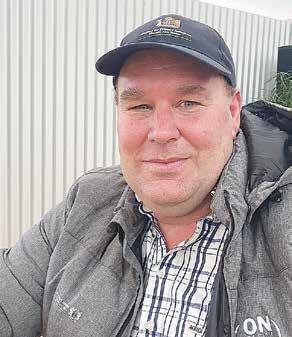
farmers choose options that would have gone in the opposite direction for improving carbon efficiency.
Next point would be: If you legislate for something, you have completely removed any desire from the market to pay more. Why would a customer pay any more for a product just because your costs have gone up
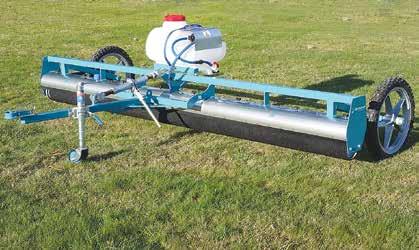

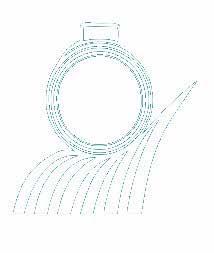

– because of government legislation?
If the market truly wants something, then the law of supply and demand applies. If we want our farmers to get premiums for doing various things, then we need to have that tension existing. At the moment, Nestlé might well say to one of our processors, “We want you to lower
the carbon footprint by 20%”. That processor could respond to Nestlé and say, “Fine, but if we do that, then we need you to pay more coin to keep the farmers happy; if we don’t, they will go to a competitor who is paying the same, but without the need for reducing emissions”. It really is that simple.
Now if all those customers like Nestlé are saying that to all the producers, then okay, no extra coin – the market has spoken. But those tensions and hard conversations need to be had, otherwise farmers won’t get the best deal.
If you ever see a processor say government needs to legislate for something, that’s a sure sign there is zero market premium to be had. Sometimes it might be justified to remove the risk of all producers ending up receiving less, but let’s not kid ourselves there is anything more
to be extracted from the market.
If a customer truly wants something, then they will be willing to pay more for it and incentivise the production of more of what they want. I learnt these basic concepts of the law of supply and demand in 3rd form Economics.
Any government that wants to consider pricing ag emissions needs to firstly make sure they are using the right science and thus applying the right targets in the first place. But most importantly, what is the problem we are trying to solve by taxing the most carbon efficient farmers in the world? Because if you argue the problem is reducing greenhouse gas emissions, then incentivising food production to move offshore at a higher emission rate doesn’t solve that problem.
• Andrew Hoggard is Associate Minister of Agriculture
OSPRI WILL carry out on-farm TB testing, following AsureQuality’s decision not to renew their contract.
Simon Andrew, OSPRIs general manager, disease control planning and integration says they are excited by this step in OSPRI’s growth as an integrated disease management agency.
“Livestock TB testing remains an indispensable part of the TBfree programme, and we’re working hard to ensure it continues at cattle and deer farms across New Zealand,” says Andrew.
“By insourcing the service, it brings us closer to our farmers and that’s particularly important given the crucial part they play in our TB eradication programme.”
Andrew says it also introduces more agility, whether that’s responsiveness to emerging technology or when changes in TB testing are needed quickly.
PORK FARMERS says a significant influx of imported pork is causing them concern.
NZPork says much of it is from countries that permit pig farming practices illegal in New Zealand, and in some cases, have herds affected by African Swine Fever (ASF).
According to data from NZPork, between January and September this year, imported pork accounted for nearly 62% of pork consumed in New Zealand.
New Zealand imported a total of 66,686 carcass weight equivalent tonnes (CWE) of pork, up from 65,566 CWE in 2023. In comparison, local pig farmers produced 41,099 CWE tonnes of New Zealand-born and raised pork, slightly down from 41,789 CWE last year.
“Almost two-thirds of the pork consumed in New Zealand is imported, yet there are no requirements for these imports to meet our stringent pig welfare standards,” says Brent Kleiss, chief executive of NZPork
NEW ZEALAND’S primary sector is being called on to help shape the future of the country’s industry by sharing views and insights about the availability and use of genetic tools.
The Informing New Zealand Beef (INZB) programme has launched its fourth annual industry survey aimed at farmers, beef breeders and rural professionals, including agricultural consultants and facilitators, stock agents and vets. The survey closes on Monday, December 9, 5pm.
INZB programme lead Dr Gemma Jenkins says findings from the previous surveys had already been incorporated into programme activities.
The seven-year programme aims to boost the sector’s profits by $460m over the next 25 years. It is developing a beef genetic evaluation system that includes traits that are important to New Zealand beef farmers, supporting a sustainable beef farming industry.
“We really encourage farmers and others involved in the sector to complete this year’s survey, even if they have already taken part in previous years. This enables us to measure changes in views and the uptake of genetic tools over time,” says Jenkins.
SILVER FERN Farms
chief executive Dan Boulton predicts that 2025 will be a better year for farmers.
He told Rural News he’s optimistic that overall farmgate returns in the coming year will be more favourable than they have been the past 12 to 18 months.
The company is now in the middle of a series of farmer roadshows and Boulton says farmers generally share his optimism, are buoyed about what they are hearing and have a bit more spring in their step.
“We have come off
the floor. North America is going to be very short of beef for the next couple of years. The big supply dynamics that we saw from South America and Australia are forecast to ease, and in the UK, lamb is in short supply and there will be some favourable gains in that space as well,” he says.
Boulton says this all points to a better balance in supply and demand which will lead to better pricing. He says, on top of that, the foundational work that SFF has done investing in their strategy, including in sustainability, is coming to the fore. He says this is resonating positively with SFF’s big corporate customers
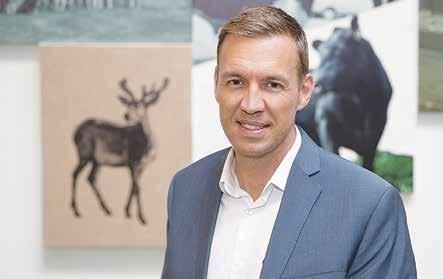
where there is value to be had. He says these initiatives are paying dividends and adds that their own survey shows they have record farmer loyalty, strong customer satisfac-
tion and a high degree of positivity from company staff. Boulton says a key message to farmers right now is to make sure they book their stock in early and liaise closely with
their livestock reps.
He says in his recent travels up the east coast of the North Island there are signs of drought and similar conditions emerging in the Waikato, King
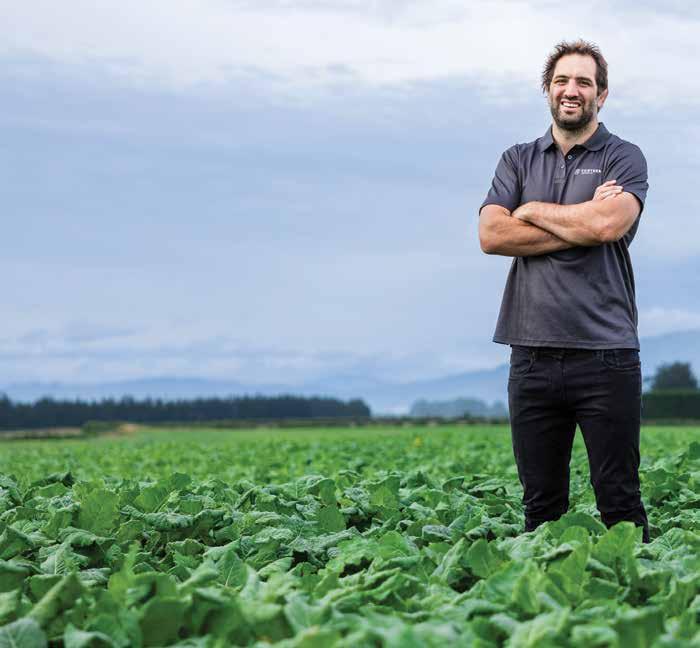
Country and the east coast of the South Island.
So far it’s been a slow start to the season and one of the quietist procurement supply windows for many years. He says this has led to challenges getting enough stock to the works and market.
The result has been good prices for bull and cow beef and even prime lambs. But he warns that this may change quickly once the season gets into full swing.
He says while SFF has been going through a quiet period, they have used this time to recruit and train some of the 1000 workers they need for the season.
“This is not unusual to previous years, but we have had to manage shifts so that we don’t have empty hooks,” he says.
But with the prospect of drier weather, Boulton is predicting a stronger finish to 2024 and one that will exceed previous seasons.
“Livestock flows are often determined by the weather and those signals of westerly winds and a dry east coast where lambs are doing pretty well will come into play. We are forecasting lambs to come forward earlier than we have seen before, so we are telling farmers to get their bookings in early to a avoid a jam up going into Christmas.”
Our portfolio of powerful, proven products has helped farmers from one end of the country to the other create and maintain thriving businesses, and has earned us a reputation as New Zealand’s brassica protection specialists. Visit corteva.co.nz to view our range of online brassica resources.
LAST WEEK around 400 farmers turned up at Mystery Creek to hear Prime Minister Christopher Luxon speak as part of Federated Farmers’ ‘The Restoring Farmer Confidence Tour’.
Judging by the reception the PM and his Agriculture Minister Todd McClay and rural MPs got from the crowd, confidence is returning to farms: the farming sector is finally getting the respect it rightly deserves.
Over the past year, the Government has kept its election promise and delivered practical reforms to reduce costs, cut red tape, provide certainty, and get Wellington out of farming.
McClay started off by saying that farmers and rural communities are the backbone of New Zealand’s economy: 80% of all goods exports come from the primary sector; more than 359,000 Kiwis are employed because of rural activity; farming, forestry, and horticulture remain a mainstay of NZ economic activity.
The Government’s ambitious target of doubling exports by value over ten years is an opportunity to work with the primary sector to add value and deliver greater returns at the farm gate.
Cutting costs and red tape in the ag sector has been a priority. The Government has introduced practical rules for on-farm water storage, restored common sense to regulations for intensive winter grazing and stock exclusion, halved Emissions Trading Scheme (ETS) charges for forest owners, paused the rollout of Freshwater Farm Plans and repealed the burdensome Log Traders legislation.
Importantly for farmers, the Government has provided clarity on emissions by disbanding the previous government’s failed He Waka Eke Noa partnership, launching an independent review of methane targets and passing legislation to remove agriculture from the ETS.
However, there’s still some unfinished business, fixing freshwater rules and the RMA to give farmers more certainty being the main ones.
The mood at the Feds meeting marked a stark difference from the previous government approach of piling regulations on the farming sector with little or no consultation. PM Luxon hit the nail on the head when he said the relationship between the Government and the farming sector “wasn’t a parent-child relationship, but an adult-adult relationship”.
He says it’s no longer about the Government telling farmers what to do. It’s getting Wellington out of farming and trusting farmers to deliver for New Zealand.
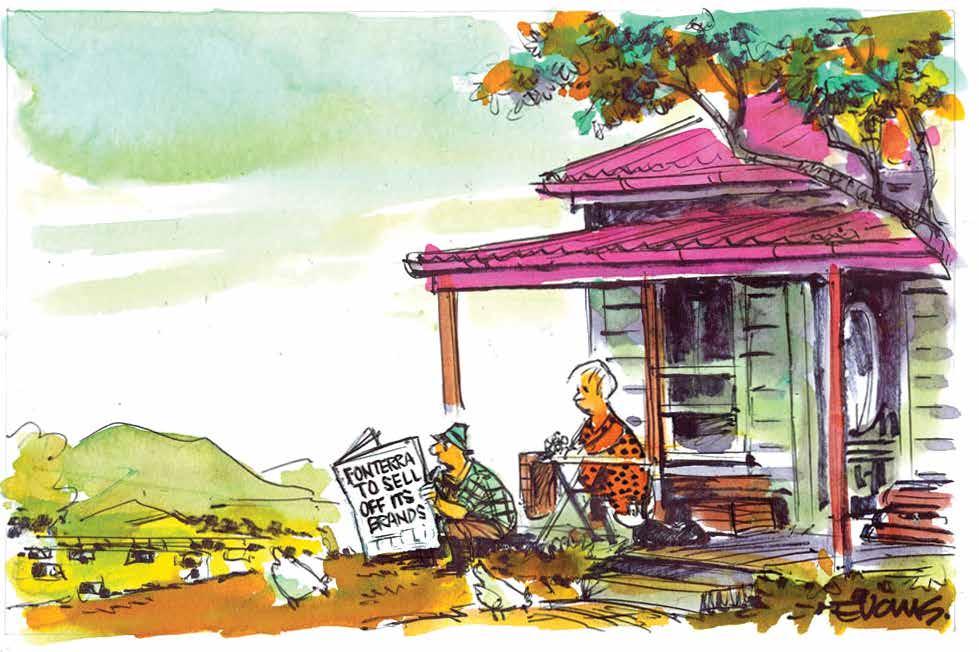
“Whatever
happened to them being vital to its ‘value added’ strategy?”
THE HOUND hears that a slickly choreographed Silver Fern Farm roadshow went astray recently when faced with fired up farmer feedback in Kurow. Chair Rob Hewett apparently shut down farmer questions on the march of forestry being escalated by companies like SFF by instead simply singing his own praises in a valedictory-type speech. One farmer asked the silently stonefaced board line-up, ‘what happens to carbon zero beef when we literally run out of offsets, do we keep planting trees until there is no land for beef?’ This question still echoes around the hills, unanswered.
HEAD OFFICE POSTAL ADDRESS: PO Box 331100, Takapuna, Auckland 0740
Phone 09-307 0399
PUBLISHER: Brian Hight Ph 09 307 0399
GENERAL MANAGER:
Adam Fricker Ph 021-842 226
EDITOR: Sudesh Kissun Ph 021-963 177 sudeshk@ruralnews.co.nz

Want to share your opinion or gossip with the Hound? Send your emails to: hound@ruralnews.co.nz
THE HOUND awaits with bated breath Nicola Shadbolt’s Methane Review Panel’s findings this month on whether farmers will continue to be marched to the gallows by legislated methane reduction targets. Rumour has it that the Panel have arrived at the only rational conclusion possible - there is literally nothing to see here, no further warming = no generic reductions needed. But unfortunately the jungle drums will be beating to justify nearly $1 billion (most of it taxpayer money) that has already been wasted chasing methane rainbows (Agrizero, The ‘Cool’ Sheep Programme, The Greenhouse Gas Consortium etc) so sadly, sector leaders won’t want the ‘no reductions needed’ recommendation that farmers deserve!
PRODUCTION: David Ferguson Ph 027 272 5372 davef@ruralnews.co.nz
Becky Williams Ph 021 100 4381 beckyw@ruralnews.co.nz
REPORTERS: Peter Burke Ph 021 224 2184 peterb@ruralnews.co.nz
Nigel Malthus Ph 021-164 4258
MACHINERY EDITOR:
Mark Daniel Ph 021 906 723 markd@ruralnews.co.nz
LANDCORP IS putting a brave face on its latest result, highlighting its progress on KPIs like climate change and gender pay gaps. Your old mate was more interested in how much they added to the Crown accounts. As Landcorp says in its 2024 report, it manages “nearly 360,000ha over 112 farms across the motu”. That’s a $2 billion asset base, on which Landcorp returned a $20m net operating profit (NOP). However, times have been tough, with falling farm product prices hitting revenue and earnings, and they made a $26m net loss after tax. For comparisons sake, that’s 39% lower than the $33m NOP of the prior year, where they lost a mere $9m after tax - on a $2b asset base. Surely, that’s the KPI that’s going to matter most to a cash-strapped government?
AUCKLAND SALES CONTACT: Stephen Pollard Ph 021 963 166 stephenp@ruralnews.co.nz
WAIKATO & WELLINGTON SALES
CONTACT: Lisa Wise Ph 027 369 9218 lisaw@ruralnews.co.nz
PRINTED BY INKWISE
ONE OF the strongest arguments for Act’s Treaty Principles Bill is probably its opponents’ total inability to raise a calm, cogent retort to it, other than intimidation and shouting the other side into silence. When the Bill had its first reading in the House, the level of debate the Maori Party members were capable of rising to was a loud, intimidating haka, designed to derail voting on the Bill and disrupt the legitimate parliamentary process. Act’s David Seymour noted, “I heard name calling, I heard hysteria, I saw a haka. I didn’t hear any argument”. Shane Jones added, if Maori Party MPs won’t respect the rules of the House, they shouldn’t come to Parliament. Your old mate reckons the attendance roll suggests they usually don’t!
SOUTH ISLAND SALES CONTACT: Kaye Sutherland Ph 021 221 1994 kayes@ruralnews.co.nz
DIGITAL STRATEGIST: Jessica Marshall Ph 021 0232 6446


SILVER FERN Farms is at a crossroads.
On one hand, they tout New Zealand’s clean, green farming image – a unique and market-leading story built on the backs of farmers who have spent decades pioneering sustainable practices.
On the other hand, they seem intent on pushing us toward unproven biotech solutions to satisfy corporate buyers’ fixation on Scope 3 emissions. The two approaches are fundamentally incompatible, and it’s time for SFF to decide where their priorities lie.
Let’s start with what we’re already doing. New Zealand farmers are the most efficient in the world. Full stop. We have already drastically
reduced stock numbers, and our emissions profile is decreasing at an alarming rate. Yet, instead of promoting the hell out of this incredible achievement to global consumers and buyers, SFF are pandering to big corporates obsessed with arbitrary emissions reduction targets. This is a cowardly and short-sighted strategy.
At the recent SFF Supplier Roadshow in Kurow, this disconnect was on full display. While SFF proudly flaunted Tesco’s 39% emissions reduction demands as their aspiration, they failed to address the bigger question: Why aren’t they educating these buyers about what we’re already doing? Why not show the Tesco’s and the Whole Foods of the world that New Zealand’s ruminant methane emissions
are a stable, short-lived gas that isn’t the climate villain it’s made out to be? Why not tell the world that, per kilogram of meat or litre of milk, New Zealand farmers are unmatched in efficiency and sustainability?
Instead, they’re steering us towards biotech tools like methane-reducing boluses and feed additives—unnatural, costly products that disrupt an animal’s natural processes. I won’t sacrifice my animals or my farm for virtue signalling and I doubt any farmer would.
At Kurow, I challenged Anna Nelson, SFF’s incoming chair, on the push for boluses and feed additives. She compared them to vaccines and drenches, but that doesn’t hold up. Those are sparingly used to protect animal welfare, not
to interfere with natural processes.
Despite me telling her bluntly: “If these products became mandatory for premiums, I might buy them, but they’d sit unused in the shed”. Clearly she’d never considered that’s how farmers might feel. That’s how absurd this is; they wouldn’t even know if they were used or not! SFF’s focus on appeasing buyers instead of standing up for farmers was obvious to everyone in that room.
It’s hard to pin down exactly how much SFF has poured into Agrizero, the JV partnership tasked with reducing biogenic methane, but make no mistake, it’s a multimillion-dollar investment from our co-op. But, before another dollar is spent, we need a serious, open conversation

about how much warming New Zealand’s ruminants are contributing. Science shows our methane emissions are already on a clear downward trajectory, yet SFF is charging ahead with unproven, costly technologies that risk undermining everything that makes our farming unique.
Of course, if we don’t go down the biotech road, the only other
option is land-use change –increasing forestry in perpetuity. This is a disaster waiting to happen. Every hectare lost to pines is another family farm gone forever. It’s a future where my children, and yours, might not have the opportunity to farm, let alone do so profitably. We cannot afford to lose more land to forestry, especially when it’s being done to meet flawed targets dictated by buyers thousands of miles away who don’t understand our land, our animals, or our way of farming.
SFF must stop pandering to Scope 3 demands and start doubling down on the story that sets us apart. Our low-input, natural, pasture-raised protein is what consumers want. Why are we risking this incredible point
of difference by chasing unattainable 39% emissions reduction targets and trying to shoehorn risky biotech solutions into farming systems that don’t need fixing? It’s a betrayal of the farmers who are their brand, their shareholders and a betrayal of NZ agriculture.
Let’s be clear, this is about more than premiums or buyer demands. It’s about integrity – standing behind the farmers who built New Zealand’s farming reputation and are leading the world with the science and sustainability we’re already achieving.
SFF need to decide: Are they here to promote NZ farmed meat or pacify corporates?
• Paige Wills is a sheep and deer farmer in the Waitaki Valley






PERSONAL RECOMMENDATIONS, often appearing as testimonials, are not the same thing as scientific research. Most people know this, yet the testimonials keep appearing. Celebrities are finding themselves in hot water (Elle McPherson’s holistic treatment leading to remission from what is now known was stage 0 cancer is a case in point). Professionals are trying to promote actual research rather than testimonials. And in agriculture we are constantly being told we should look to new solutions that are backed by, you guessed it, testimonials.
Testimonials can sometimes be validated through research, but the importance of the crystal effect must never be forgotten. David Swain, agricultural science editor for decades, explained to the uninitiated that a crystal placed in the centre of a farm, and turned through 90 degrees daily, would increase farm productivity. The key was to approach the crystal from a different direction and leave in another direction, every day. And on the way the farmer noticed that the ewes needed drenching, the fence needed mending, the calves needed moving, the pasture needed topping…
The crystal gave renewed interest which in turn increased productivity.

Human response is key and is one of the factors that scientific research tries to eliminate when identifying drivers of change. Other factors are removing the effect of field variability using replication and controls, and repeating the research in different seasons, years and, possibly, location – all in an effort to be sure that the outcome is due to a driver, not chance.
Nitrogen (N) use is one of the changes being regulated in agriculture. Farmers trying to stay solvent are being urged to cut use of nitrogen fertiliser and many companies are trying to assist. Ravensdown and Ballance have produced a range of options with the overall mantra of Right Product, Right Amount, Right Place and Right Time. Other companies have produced proprietary formulations which appear to be effective in some circumstances.
Dr Rachael Bryant, Associate Professor in Lincoln University’s Depart-
ment of Agricultural Sciences, specialises in pasture agronomy, including the impact of technologies. Much of her research involves finding commercial tools to solve practical problems. She works with farmers and industry professionals, testing ideas and then explaining the outcomes. Some of her latest research, funded by MPI, was presented at the NZ Grassland Association Conference held in Oamaru at the beginning of November. Her paper (with co-authors Greig and Mangwe) is freely available on the Grassland.org.nz website.
The plot trial research examined whether tactical use of N fertiliser, applied with or without coating or biostimulant, improved herbage yield and N use efficiency. Results indicated that when applied at the same rate, but different timings, combining urea with a coating or biostimulant altered the distribution of pasture growth, but did not affect net annual production or herbage quality. The greater applica-
tion costs associated with liquid versus granular products meant that the new products achieved the same response as urea but with greater expense.
This was at the Lincoln test site, which Dr Bryant is quick to acknowledge is a relatively high fertility site, but nitrogen response was shown by the difference in yield between zero N addition and the N treatments.
The outcome was not new but did use currently available products.
Dr Doug Edmeades, soil scientist and managing director of agKnowledge, has explained the science behind products repeatedly. His explanations can be found on the agKnowledge website (agknowledge.co.nz) in Fertiliser Review. Chemical versus biological fertiliser is one of the tabs linking to seven informative articles.
Another tab is the Base Saturation Ratio Theory (Kinsey-Albrecht) with six articles explaining the two different approaches and why, for New Zealand, sticking with the MPI (MAF and various predecessors) approach is more likely to achieve least cost responses. This is because it focuses on overcoming limitations to production by applying necessary nutrients.
action would need to be taken by our industry.
IF YOU have kept your finger on the emissions pulse, none of the below information will be a surprise to you. However, if you are a farmer that has not been following New Zealand’s ruminant methane issue then you may be in for a nasty shock.
To keep it short, New Zealand agriculture has been falsely accused of contributing to 50% of the country’s greenhouse gas (GHG) emissions. I use the word ‘falsely’ because that is exactly what has occurred. An outdated metric has been used to model New Zealand’s GHG emissions contributions. Even the IPCC themselves have stated that the metric is unfit for purpose.
If New Zealand’s GHG emissions model had been updated to the newer metric and due to our falling stock numbers, our agricultural contributions would be minimum and no
We could keep producing the world’s lowest emission meat and dairy products exactly the way we always have done.
For reasons unknown, not one politician or industry leader has had the balls to call out this treasonous behaviour towards our country and our agricultural industry.
Instead, what has unfolded is the biggest example of ‘Group Think’ ever experienced by our industry. Instead of questioning the faulty models head on, which would have been the true and fair thing to do for our industry, agricultural representatives jumped on the emissions bus whilst saying, ‘We can still farm productively and profitably by simply incorporating some ruminant emissions tools into our businesses’.
What’s worse is they went to our industry for support when they didn’t
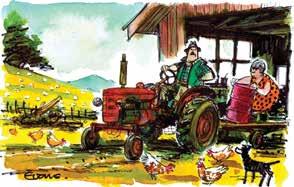
even have any details themselves on what those mitigation tools might look like.
Fast forward the out-of-control emissions bus to now and our industry is facing some very bitter decisions.
It is openly quoted by AgriZero (public-private partnership) that farms will each require two to three tools to achieve a 30% reduction in methane and nitrous oxide, with the first of these potentially available from 2030. No one has ever bothered to explain where the outlandish suggestion that we need to decrease our emissions by a further 30% came from, or why.
Let’s look closely at the information on the mitigation tools to date:
Methane bolus: needs reapplication every 100 days. Highly unsuitable for large animals due to the safety risks associated with application. Highly impractical for large
herd/flock numbers. No details yet on price or supplier.
Methane bolus containing a daffodil compound: being researched and trialled at present. Highly impractical for large herd/flock numbers. No details yet on price or supplier.
Methane vaccine: tens of millions of dollars has been sunk into methane vaccine research to date. No details yet on price, supplier or frequency of application.
Low methane genetics (rams/ bulls): released research shows the low methane animals are leaner and woollier. All the coffee table conversations state that the low methane animals are smaller.
Has anyone tasted the leaner animals, given that fat is what gives lamb its flavour?
All those methane vaccines and boluses will be going straight in the bin, by the way, there is nil benefit to the farmer for trying to stuff them
Agricultural research started in New Zealand over 100 years ago and has developed an approach that is appropriate for the soils and environment, as well as different farming systems. That approach involves pasture species as well as nutrients, and has been tried, tested and documented for decades. The first reports of the NZ Grassland Association conferences were published in the 1930s, and some of the fundamental principles of management have not changed.
Nor has the desire for scientists, farmers and rural professionals to work together to identify ‘a better way’.
Testimonials can be a very good start to an investigation. The questions on ‘why was the change made and how appropriate are the circumstances to my operation?’ might assist the next steps. But it is scientific research that will examine the drivers of change and be able to identify what made the difference.
• Dr Jacqueline Rowarth, Adjunct Professor Lincoln University, has an honours degree in Environmental agriculture, a PhD in Soil Science and is on the board of directors of DairyNZ, Deer Industry NZ and Ravensdown.
down their animals’ throats. Winners: Biotech companies and their shareholders.
Losers: NZ Farmers and the environment.
Apparently, NZ farmers just need to put up and shut up though as these biotech tools will be an essential requirement for market and trade requirements and bank loans, regardless of the fact that none of this will make any measurable difference to the global temperature, as ruminant contribution to warming is so miniscule it is immeasurable.
Winners: Biotech companies and their shareholders.
Losers: NZ farmers, our free-range/ low-input advantage, the New Zealand economy and New Zealand environment.
• Helen Mandeno is a Waikato sheep and beef farmer


The Ministry for Primary Industries (MPI) is encouraging anyone with poultry or pet birds to prepare for the possible arrival of bird flu.
New Zealand has never had a case of high pathogenicity avian influenza (HPAI), also known as bird flu, and government agencies are keeping a close watch on events overseas and preparing.
In countries with HPAI, the disease is not a food safety issue and it is safe to eat chicken and egg products that are thoroughly cooked.
“While HPAI is still some distance from New Zealand and we’ve never had a case here, it’s important that we take a cautious approach,” says MPI’s Chief Veterinary Officer, Dr Mary van Andel.
MPI has launched a summer campaign to raise awareness of HPAI – targeting people on lifestyle blocks, city-dwellers with backyard poultry, bird fanciers, rare breed keepers and people with pet birds.
Dr van Andel says we can all help to reduce the potential impacts of H5N1 by being prepared.
“Everyone has a part to play.

We are encouraging people who own backyard or domestic poultry, heritage breeds or other pet birds to be ready for bird flu by practising good biosecurity.”
The HPAI H5N1 strain that has been spreading globally since 2020 is spread by direct contact between infected and healthy birds, and indirectly through contaminated equipment, materials, water and feed.
The best way to keep your birds safe is to prevent them having contact with inflected birds or contaminated materials and environments.
“This means keeping your birds away from wild birds, maintaining good hygiene whenever you’re handling or working with birds, and keeping their feed,
• Lack of energy/reluctance to move.
• Eating less than normal.
• Droopy head.
• Darkened and/or swollen comb/wattle.
• Coughing, panting and runny nostrils.
• Swelling around the head and neck.
• Laying fewer eggs than normal.
• Watery or green diarrhoea.
• Bruises on body and legs.
• A silent hen house.
If you see dead birds, call our pest and disease hotline on 0800 80 99 66
water and bedding free of contamination.
“If HPAI spreads to New Zealand, it’s likely to become established in our wild bird population, so having good biosecurity practices in place will help to protect your birds from the disease.”
Since the new H5N1 strain emerged in 2020, government agencies and industry have been keeping a close watch on the spread of the disease overseas, and preparing should it get to New Zealand.
MPI has been working in partnership with poultry in-
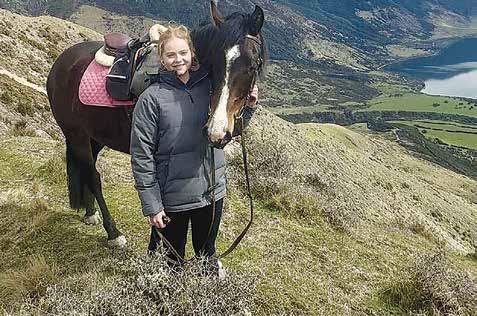
The Ministry for Primary Industries (MPI) has awarded six tertiary students scholarships as part of efforts to boost on-the-ground support for farmers and growers.
The On Farm Support Science Scholarships, for the 2025 academic year, are each worth $5,000.
They have been awarded to Lincoln University students Georgia Higinbottom, Ashton Robinson and Henry Bartrum, Massey University students Mac Williams and Ella Bryan. and Otago University student Georgie Burdon, who
are studying agricultural science, veterinary science, science, or commerce.
They range from an experienced shepherd to a student studying soil science and a recent FMG Young Farmer of the Year grand finalist.
The scholarships help build a knowledgeable advisory sector ready to provide practical, specialised support to our primary industries.
Eligibility for the scholarships, which were launched in 2023, was widened this year to include multiple universities and institutes of technology.
dustry bodies the Poultry Industry Association of New Zealand and the Egg Producers Federation on business continuity and resilience in the event of an outbreak of HPAI, and making sure farmers and growers have strong biosecurity in place.
“The implementation of rigorous on-farm biosecurity now, before an incursion, has the potential to protect individual farms from infection and to limit impacts on the domestic supply of poultry meat and eggs,” says Dr van Andel.
Advice from New Zealand
health agencies is that it is very rare for humans to be infected with HPAI even if they are exposed.
According to Health New Zealand’s health information and services website, in other countries where HPAI is present, human infection has generally only been found in people who have had a lot of contact with infected birds or other infected animals.
There has never been a case of HPAI in humans reported in New Zealand and currently, the risk of infection here is low. In fact, the World Health Organization (WHO) has assessed that the overall public health risk to humans globally is low.
More information
Detailed advice for bird owners is available at www.mpi.govt.nz/Bird-flu
Information on HPAI, including on the implications for human health and food safety, is available at www.mpi.govt.nz/HPAI
If you see dead birds, call our pest and disease hotline on 0800 80 99 66
Farmers are being encouraged to use nitrogen and careful management to set their pastures up to thrive and survive this summer.
NIWA forecasters are predicting dry spells, especially in the west of both islands, and above average temperatures across the country until the end of January.
“There are lots of small decisions farmers and lifestyle block owners can make to set themselves up for a successful summer,” says MPI’s director of On Farm Support, Dr John Roche.
enable saturated paddocks to dry out and farmers to focus on restocking depleted supplementary feed supplies, where possible.”
Dr Roche says industry bodies DairyNZ and Beef + Lamb New Zealand have excellent online resources to support farmers.

“The most important thing is to identify pasture surpluses and either harvest them, as hay or silage, or close the gate on them and defer the grazing until January or February to fill feed gaps later in the season.
“Applying nitrogen to pasture in December encourages tillering and plant survival and sets grass up for summer growth.
“Extending round length can help build feed covers. Dairy farmers should aim to be on a round of 30-plus days by mid to late December, depending on covers and where in the country they are farming.”
Dr Roche says it’s important farmers farm to the conditions in their region.
“Southland has had an incredibly wet spring, which has been extremely challenging for farmers,” Dr Roche says.
“The forecast drier, warmer weather will
“There are plenty of tactics farmers and lifestyle block owners can use to increase feed supply or decrease demand,” Dr Roche says.
“Identifying and selling early culls, lambs that have hit target weight, or prime livestock can help reduce mouths to feed.
“It’s also a good opportunity to look at your feed needs for the coming months. If bought-in supplement is part of your summer strategy consider contracting ahead, before the weather gets dry, to ensure availability at a price that works for your budget.
“Many regions had good spring growing conditions enabling surpluses to be harvested to help build a buffer of feed heading into summer.
“Recent rain has been welcome farmers in North Canterbury and parts of the eastern South Island and lower North Island which had very dry, challenging conditions from last summer into winter.”
Forecasters say if La Niña develops it is likely to be weak and short-lived.
To contact On Farm Support, call freephone 0800 70 71 33 or email onfarmsupport@mpi.govt.nz
ORGANISERS
OF the Christchurch A&P show say they are happy with this year’s event despite a rushed turnaround that left agricultural industry support thin on the ground.
Although the show has been a centrepiece of Canterbury’s Show Week for many decades, in April the then Canterbury A&P board cited financial pressures in a shock announcement that there would be no full-scale public show this year.
Only the Canterbury Agricultural and Pastoral Association (CAPA) livestock and other competition classes would go ahead - without the public, as they had through two Covid show cancellations.
However, an approach from event management company Event Hire gained grassroots support from the wider association, leading to the ousting of the old board and a new board giving Event Hire the go-ahead in August to run a public show.
Both Event Hire and the board say they are happy with the event, saying it met public attendance and other targets despite many of the big traditional rural supporters being unable to attend.
“With a 90-day turnaround we really needed support from the trade, from the public, from the food trucks, from the entertainers. And we


really needed support from the [A&P] Association. And they all came through, so we’ve had a fantastic show,” said Event Hire’s event manager Karl Horwarth.
The show met a target of around 60,000 people over the three days –despite possibly the poorest show weather for many years. They had also met their target of around 300 trade sites.
But conspicuous by
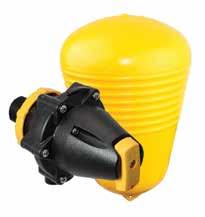
their absence were many traditional big supporters.
Horwarth said that when the old board announced the cancellation, several of the big rural trade sites, like PGG Wrightson, Ravensdown and Silver Fern Farms, committed their staff and their budgets elsewhere. When the new board gave the go-ahead in August, giving Event Hire just a 90-day turnaround,
• Ideal for Cattle Troughs
• High Flow
• Side/Bottom Mount
• Detach to Clean
they went back to those companies, but they were unable to commit.
“We still got some good support from some of those big rural guys. They couldn’t have the presence, but some of them were able to give sponsorship dollars. Some were able to give equipment.
“Now they’ve all pretty much said that they’ll be back in 2025.”
Speaking on the
second day of the event, the new board chair, Sir David Carter, said it had gone “unbelievably well” with great attendance despite a shower of rain early on the opening day.
“Today’s been fabulous. At one stage I heard a complaint that it was taking too long at the gates to buy your tickets. As an event organiser, that is a wonderful complaint to get.”
CAPA show president
BRYCE MURRAY says the timing of the next show is a question to be decided, probably early in the new year.
“There’s probably going to be quite a bit of debate about that,” said Murray.
The public show and the bulk of the competition classes traditionally run Wednesday, Thursday, Friday – Friday being Show Day, Canterbury’s statutory anniversary holiday and usually the busiest day of the show. At Event Hire’s request, this year’s public show ran Thursday Friday Saturday, in the hope that it would give working people one more day to attend, despite there being almost no livestock left on site to see by Saturday.
One possibility is to push the competition classes back a day to match a Thursday Friday Saturday public show.
However, that is not supported by show stalwart, Tai Tapu Holstein Friesian breeder Dean Geddes.
Geddes, who is from a family that has been showing for more than 106 years and hasn’t missed a show in decades, points out that in the traditionally busy Canterbury Show Week, Saturday is for the New Zealand Cup at the Riccarton gallops.
“You won’t have me here then, because that’s my racing. That’s my day off.”
Geddes was speaking to Rural News on the Friday afternoon of the show, when almost all dairy entries had already gone home, apart from a few calves and Geddes’s Tahora Pharo Abriana, which had been named Supreme Champion Dairy Cow of the show, and was awaiting the judging of the overall Supreme Champion Animal.
Geddes said that while it would be a shame for the public to have no livestock to see on the Saturday, showing dairy cows was a big commitment taking up nearly a whole week. He brings his animals into the showgrounds on the Sunday to get them used to the chlorinated town supply water, then has to employ staff to milk them and stay with them 24 hours a day, while other staff continue to run the farm. Then it takes a couple of days to wean them back onto grass.
“And I’ve had 20 cows here – more than anyone.”
Bryce Murray promised that next year would be better.
A board meeting after the show confirmed the intention to go ahead with Event Hire again next year, he said.
Event Hire co-owner and director Philip
Anderson said the show had been a great experience and they learnt a lot. Feedback from the board, the committee and the various show sections had all been positive, he said.
@rural_news facebook.com/ruralnews


• Compact/Robust

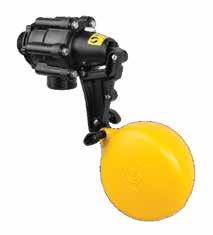
• Up to 50mm Inlet
• Flows up to 600L/min
• For Storage Tanks
• Easy Access to Valve • Inlets Upto 50mm • Avoids Starting & Stopping of Pump When Tank is Filling

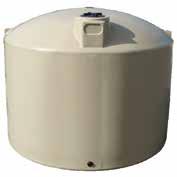
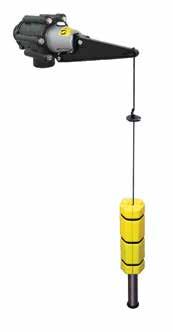
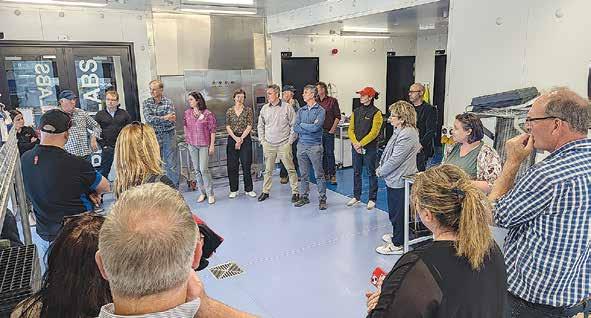
THE CANTERBURY Growers Society will soon be seeking sponsorship for a new regional young grower competition, after an absence of several years.
While other regions – Pukekohe, Central Otago, Hawke’s Bay, Nelson, Gisborne and Bay of Plenty – have run regular competitions with winners competing for a national title, Canterbury has not.
Restarting the regional competition is part of a plan to reinvigorate the group by the new chairman, Rob Lindsay.
The group, with about 250 on its base emailing list out of an estimated 500 fruit and vegetable growers across the province, is seeking ways to re-engage with growers and ensure they know where they can turn to for support and information.
Lindsay says Canterbury Growers has been a functioning society for nearly 100 years, existing to support growers and ensure that people who need help in an emergency, receive it. But restarting the competition is the group’s “succession plan”.
“It brings growers together. It brings young people along,” says Lindsay.
“Young people are the future of this industry, so if we can help them, teach them, mentor them, support them, that’s a good thing.”
Lindsay says they are now talking to various stakeholders to decide when to run it, to best fit in with various members’ growing calendars, but it would probably be in May or June.
“In Canterbury, we have a large area under potatoes in Mid and South Canterbury. We represent 20% of the nation’s onion production and we have a lot of market gardens in North Middle and South Canterbury.
“And there’s some fruit starting to be grown again, too. We’ve got some modern format orchards being put in.”
Lindsay is based at Clarkville, just north of Christchurch, where he grows telegraph cucumbers hydroponically, with about 1.6ha under cover. He has been the group chair for about two months.
ONE OF Rob Lindsay’s first acts as chair of the Canterbury Growers group was to host a meeting of the executive in conjunction with a visit by members to AgResearch’s new glasshouse facility at Lincoln.

The facility is unique in New Zealand, being the only one where scientists can conduct secure, contained research on microorganisms, insects and plants all under one roof.
It is expected to modernise agricultural research by providing a contained, efficient environment for multi-trophic studies—research that examines the complex interactions among multiple organisms within an ecosystem.
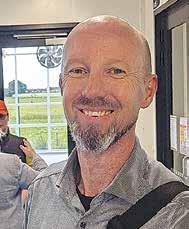
The $11 million, 402 square metre facility is certified to PC2 (Physical Containment 2) standards, with spaces kept at low atmospheric pressure so air only goes in through any opening and only goes out through high-quality filtration.
AgResearch says that ensures that every aspect of an experiment, from fumigation protocols to pollen sterilisation, is meticulously controlled, reducing risks, speeding up research, and reducing costs.
“No other research facility in New Zealand combines these capabilities in a single, purpose-built environment,” says research associate and glasshouse manager, Sarah Jackman. “That’s what makes it so exciting.”
The facility can simulate complex scenarios involving multiple organisms. For example, scientists can study gene-edited ryegrass interacting with an exotic insect. Unlike overseas studies, which may not address New Zealand’s unique flora and fauna, it allows for research specifically tailored to New Zealand’s agricultural ecosystem.
Other advanced features include an infrared-capable lighting system, which simulates a full spectrum of sunlight, and a specialised water filtration system.
Jackman expects research to begin on Fall Army worm, Green Vegetable Beetle, Porina, and the Coconut Rhinoceros Beetle, which is a major pest in the Pacific.
AgResearch is inviting expressions of interest from potential clients interested in research partnerships.
HOW MUCH shade and shelter do our sheep need in an era of more extreme weather and the lack of natural shelter on farms?
That’s the question Associate Professor Rene Corner-Thomas from Massey University is trying to determine as part of a significant joint Massey and Lincoln University funded research project being carried out at the Massey’s Riverside research farm near Masterton in the Wairarapa. She says they initiated the project because of the ongoing weather effects of climate change and the fact that there has been a reduction in the amount of natural shade and shelter provided on farms due to the introduction of centre pivot irrigators and movement of sheep farms to more extreme environments. Corner-Thomas says lack of shade and shelter can have a direct effect on productivity and profitability.
“While sheep are hardy animals, when the environment gets hot it can affect their productivity because it tends to cause them to eat

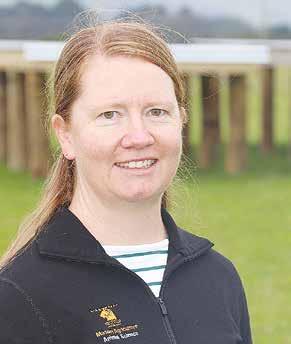
“What we are trying to measure is exactly how much shade sheep need in order to help farmers to work out the shelter for their specific animals and farms.”
less. Because they have a lower feed intake, they don’t grow as fast as they should and ewes may not produce as much milk, so

■ Ideal for shearing sheep, alpacas, goats and cow tails.
■ Variable speed from 2600-3500 rpm.
■ Latest brushless motor technology means minimal heat build up
■ 1400gms means 100200gms lighter than standard handpiece.
■ At 2800 rpm the 12-volt lithium battery will crutch 300-400 sheep or trim 400-500 cow tails.
■ We can customise cables for lifestyle shearers


the lambs will grow more slowly,” she says.
To get robust data, Corner-Thomas and her team have built a series of shade and shelter structures and monitored animals using GPS and video technology. A weather station has also been installed to give accurate data on the weather conditions during the trial.
Three 1.5-hectare paddocks have been set aside and a wooden shade structure has been built in each.
In one paddock the shelter allows for 0.5m2 per ewe, the next paddock 1m2 and 2m2 in the third trial paddock. Twenty sheep are being grazed in each of these –half of which are shorn and the other half with their wool left on.
In each of the paddocks, but located a considerable distance from the main wooden structure, is a small area of windbreak attached to the fence with the aim
of providing shelter from the strong westerly winds often experienced at Riverside.
“What we are trying to measure is exactly how much shade sheep need in order to help farmers to work out the shelter for their specific animals and farms. This will also help the government to develop policies around animal welfare on farm,” she says.
Each sheep has a collar with a GPS tracker attached to see exactly where they are in relation to the shelter. This collar does not harm or affect the animal. They also record the temperature the sheep are experiencing using a logger on the collar. This collects both the body and external temperature of the sheep so that scientists can assess the body’s response to the conditions.
“We also have video cameras which are motion activated and located on a post in front of each of the shade structures. We have a similar camera set up at the wind shelter so that we can visually record how sheep are making use of these structures,” says Rene CornerThomas.
ANOTHER FACTOR being measured as part of this trial is the social interaction between the sheep.
Associate Professor Rene Corner-Thomas says sheep have their own hierarchy and if a dominant sheep is using the shade structure, less dominant sheep may be reluctant to go there. As a result, she says some sheep may not get the access to shade that they need.
The trial started in February this year and ran for one week in every month up until July. Corner-Thomas says the trial will resume in December and run through the summer months until February. The same trial is being carried out at by Dr David Scobie and his team at Lincoln University.
Corner-Thomas admits that the shelters that have been built at Riverside are ‘overengineered’ and she wouldn’t expect farmers to build something similar. She says pivot irrigators have seen many trees in paddocks removed but points out there are other shrub options that the irrigators can roll over. More shelter belts are also an option she adds.
She hopes this trial will back up the anecdotal evidence that sheep actively seek shade when it gets hot.
“On hot days, I have seen sheep sitting in even the smallest patch of shade such as that provided by fence posts,” she says.
She believes that animal welfare has always been important to many in NZ. But she says now it is becoming a vital part of the NZ story to assure our markets that not only is our food of the highest quality, healthy, safe and nutritional, but that our animals were well cared for.
FARMCHIEF MACHINERY has been announced as the distributor of Einboeck agricultural equipment in New Zealand, taking over the mantle from previous distributor Tulloch Farm Machines, Masterton.
“We see great potential, particularly in the area of reseeding and weed control, to offer New Zealand farmers an economical and sustainable solution for grassland care,” says Grant Murray, CEO of FarmChief.
Einboeck’s grassland weeder and the P-BoxSTI pneumatic seeding box uses a tined seeder to effectively remove weeds
and dead grass, promoting tillering and sward vitality, while the seeding units deliver versatile seeding options and precise quantity dosing to ensure optimal germination conditions and a dense pasture.
Einboeck is a 4th generation, Austrian family-owned company that has set itself the goal of offering the best technology for mechanical weeding. This includes a wide range of tined weeders for arable crops and grassland care, to stateof-the-art row-crop cultivators for speciality and vegetable crops with camera or Section-Control.
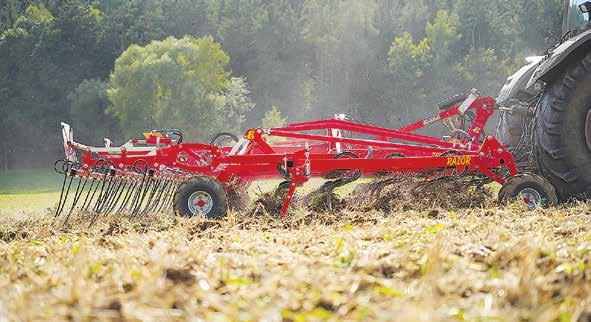
With nearly 50 years of experience supporting New Zealand agriculture, FarmChief will use the collaboration to promote interest in areas such as organic grassland care and Fusion Farming, which are already known and increasing in popu-

FIL, THE animal health and dairy hygiene subsidiary of GEA Farm Technologies, is dropping the the price for its chlorhexidine teat spray products.
The company says the adjustment comes because of recent shifts in global supply and demand of key raw materials, reinforcing FIL’s ongoing commitment to supporting New Zealand dairy farmers.
“During the peak of the Covid-19 pandemic, chlorhexidine prices rose significantly due to unprecedented disruptions in supply chains and increased demand for chemical-based products,” said Ian Palmer, senior director representative for GEA Farm Technologies New Zealand.
“Now, with the easing of the pandemic and stabilisation of global mar-
kets, demand has declined across some of our raw materials, allowing us to make cost adjustments and pass these savings on to our customers without compromising quality.”
Looking ahead, there are some anticipated cost challenges in other areas of the industry, particularly with iodine-based products.
“The demand for Iodine remains high due to ongoing pharmaceutical needs and global uncertainties, including the Ukraine-Russia conflict,” says Palmer. “With iodine mining operations confined to Japan and Chile, price volatility continues, but we remain vigilant and will continue to closely monitor iodine availability and cost.”
larity in Europe.
In other news, Einboeck is expanding its tillage product portfolio with the Razor – a flat cultivator that combines razor-sharp, full-surface
shallow and ultra-flat tillage with impressive flexibility and precision. This concept is said to deliver reduced wear and tear and fuel consumption, leading to lower overall operating costs.
The Razor is also ideal as a mechanical alternative to herbicides, offering precise incorporation of cover crops in spring or stubble cultivation in
summer, down to a working depth of 12cm.
Offered in 4m or 6m working widths, with five rows of Herkules sprung S-tines set at 15cm spacing, featuring narrow or duck-foot points with up to 90mm of overlap, the rear of the machines offer three rows of 12mm weeder tines.
Depth control is achieved with rollers or tractor profile wheels, with hydraulic adjustment, complemented by front-mounted assemblies to achieve a level finish in all conditions.
The rearward weeder tines, guided by a parallelogram, ensure that roots, weeds and grasses are brought to the surface, uprooted and laid down on top to dry.


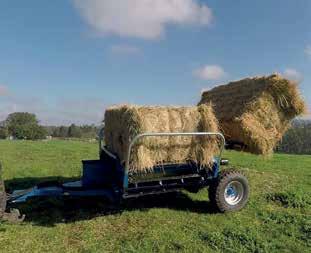


MARK DANIEL markd@ruralnews.co.nz
WITH ROOTS dating back to 2004, Origin Ag was formed as a co-operative business model that removed the traditional distributor, using the backing and support of farm machinery retailers, to introduce European machinery brands to the New Zealand’s farm machinery market.
Managing director David Donnelly, already well known in the industry as Double D, says “We knew that simply starting up a new company to import farm machinery and introduce new prod-
ucts would be difficult, so we needed a ‘point of difference’ that would benefit both the farm machinery retailer and their customers.”
Twenty years on, the company imports Alpego cultivation and seeding equipment, Bogballe fertiliser spreaders, Gascon cultivation equipment, Hatsenbichler air seeders and tine arrows, Joskin effluent tankers, muck spreaders and trailers, and Pottinger harvesting and cultivation equipment, cumulatively covering the agricultural, viticultural, horticultural, and civil construction trailer markets.
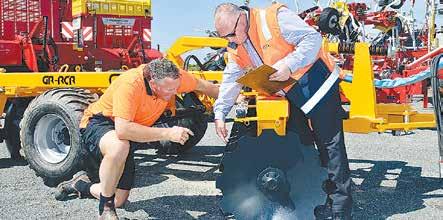
Origin Ag’s founding dealers are typically family owned, like the majority of its European suppliers, with both parties focusing on a customer-centric approach, who in turn are also largely family enterprises.
Currently, 28 individually owned and operated farm machinery dealer retailers cover NZ from Whangarei to Invercargill for after sales, spare parts and servicing requirements.
“We pride ourselves
A NEW agreement will strengthen New Zealand’s agri-tech sector by fostering a shared commitment to innovation with the United Kingdom.
AgriTechNZ and the UK AgriTech Centre (UKATC) have signed a Memorandum of Understanding (MoU) to strengthen ties and promote knowledge, expertise, and innovation exchange between New Zealand and the United Kingdom.
“This agreement marks a significant milestone in our mission to foster global partnerships and innovation across the agritech sector. By creating bidirectional pathways between New Zealand and the UK, we are amplifying opportunities for collaboration and shared solutions to advance agricultural knowledge and innovation,” says Bridgit Hawkins, chair of AgriTechNZ.
“We greatly welcome the proposed collaboration under a MoU with AgriTechNZ. Working together not only highlights the importance of
partnership working in this area, but demonstrates the potential positive impact we can have on the agri-tech industry. I look forward to seeing fruitful opportunities develop to the benefit of both countries,” says Phil Bicknell, chief executive at the UK Agri-Tech Centre.
The MoU outlines initiatives that focus on sharing expertise and insights to support innovation, alongside helping companies navigate new markets through tailored incubation and resources.
Meanwhile, webinars, workshops, and trade missions will help strengthen industry connections, while collaborative research will foster links to tackle mutual priorities
The collaboration will help connect farm trial networks in both countries, allowing innovators to test solutions in the opposite hemisphere, with the added benefit of exploring joint bids for Horizon Europe – the EU’s flagship research

and innovation funding programme.
UKATC will support New Zealand companies entering the UK market, while AgriTech NZ will support UK companies in New Zealand, ensuring both benefit from shared expertise. By leveraging their collective expertise, AgriTechNZ and UKATC aim to empower businesses, enhance productivity, and drive sustainable agricultural practices.
“This agreement is going to help farmers and innovators on both sides of the world, working together for the greater good,” says Iona Thomas, OBE, British High Commissioner to New Zealand.
“Technology and collaboration are key to furthering innovative primary production and doubling export value, so it’s great to see the partnership between the UK and NZ agri-tech organisations providing robust outcomes for farmers, trade and ecosystems,” says New Zealand’s Minister for Trade and Agriculture, Todd McClay. – Mark Daniel
on providing dealers and customers a one-on-one experience, with questions, answers and solutions addressed straight away,” says David.
Darryl Russell, managing director of Piako Tractors, one of Origin
Ag’s founding shareholders says, “Our customers enjoy the close-knit relationship we have with Origin Ag, meaning they can pick up the phone to Piako or Origin Ag and have an answer in a matter of minutes – a huge point of difference in the agricultural business today.
In terms of the Origin Ag products, our customer base really likes the idea that we are directly associated as a shareholder in Origin Ag, and the quality, which is second to none in many areas”.
Robby Smith, director of Stevenson and Taylor,
who were one of the first dealers to sign-on back in 2005, explains: “We were excited by the access to a wide variety of gear that was not offered in New Zealand at the time. Being part of its unique cooperative structure has given us a significant advantage in the industry. Being a family business, their values align closely with ours, making our partnership all the more meaningful. Origin Ag’s motto of “We have you covered” reaffirms the company’s values and that they can provide backup service for their products all over New Zealand”.
GERMAN SEEDING specialists Horsch have announced a new 1600litre double-tank option that will join its current Partner FT single tank line-up.
In addition, there are also plans for new double-tank models for 2025, with 1700l (1.7 FT) and 2100l (2.1 FT) capacities, alongside a 2500l (2.5 FT) tripletank unit.
Said to provide greater flexibility when applying one or more components, the front tanks can be combined with seed drills or alternatively used to apply fertiliser at depth while cultivating. They can also be combined with the Transformer VF, Cura ST or Finer SL.

Like the Pronto, Versa and Avatar, the latest Partner FTs are equipped with the I-Manager operating system, with new packer options transferring the weight to the front of the tractor to optimise the weight distribution and minimise compaction.
Specifically designed support kits for the pneumatic piping for the existing front hop-
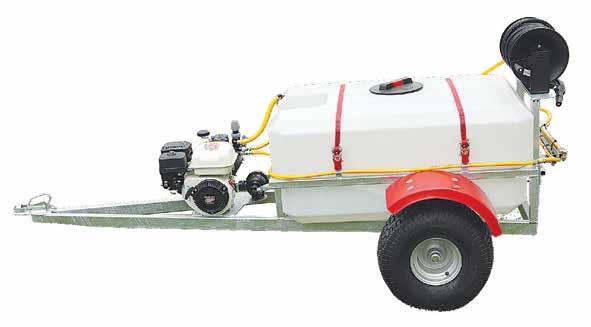

pers is also compatible with the new models. The kit consists of an adjustable attachment arm that can be positioned for height and attachment angle depending on the tractor. New quick couplers are said to provide a timesaving and toolfree method to connect the pneumatic hoses from mounted rear implements to the front mounted tank.









